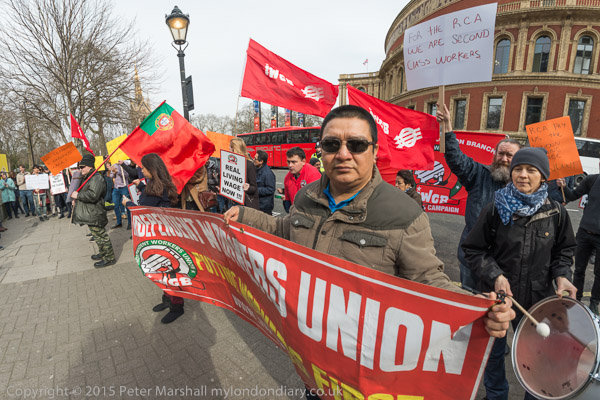
NIKON D800E: 16mm 1/250s, f/8, ISO 200, -0.3Ev
My photography has only had the most tenuous connection with the Royal College of Art, in that the first photographer I got to know in person had recently studied there and was still on the buzz, and that I’ve occasionally made just a little fun of John Hedgecoe who founded the photography course there in 1965, or rather his enormous output of glossily re-packaged how-to-do-it manuals on photography. You can find hundreds if not thousands of his pictures on Topfoto, but while it would be impossible to knock the professionalism, I find it had to see any personal style. It is perhaps curious that someone who so effectively epitomised photography as a trade should have been the driving force behind the UK’s most prestigious photography course at a college of art, though of course it does much to explain the impact that later courses at Derby and Trent had on photography in the UK.
But in the past months I’ve visited the Royal College twice, though not actually going inside, but in the company of cleaners, who have been demanding that they be paid the London Living Wage now, not from September as the college has offered. It may seem a relatively minor issue, but if you are living below the poverty line (and the living wage is the poverty line) then even a small difference is vital. If you can’t afford to take the tube for example, your daily journeys to and from work may add an hour or two to your working day, and not having to choose between eating enough and heating your flat is a great liberation.
The cleaners were joined in their protest by quite a few students from the college and you can read more about what actually happened in Poverty pay at the Royal College of Art.
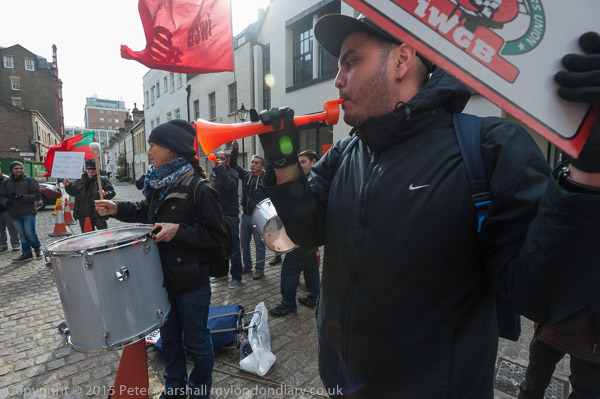
NIKON D700: 16.0-35.0 mm at 16mm, 1/250s, f/8, ISO 640, +0.7Ev
The protest was at lunchtime, at the light was good, slightly hazy sun that meant the shadows were not too harsh, although the March sun was fairly low in the sky, and despite using a lens hood there were some images with ghosting and flare. With the 16-35mm the lens hood makes a difference but doesn’t work as well as it might at all focal lengths. Lens hoods have their limits in any case, and the ‘petal’ shaped Nikon hood does its best, though at times a carefully placed left hand resting on it can add a little extra shielding (though often it turns out to be slightly less carefully placed than it seemed through the viewfinder and require a little cropping to remove it.)
But it’s impossible to avoid flare and ghosting, and generally zoom lenses suffer more than primes. Optically there is little otherwise to choose between them now, largely a choice between the discipline of working with a single focal length and the versatility of the zoom. With digital giving high quality at high ISO, the wider apertures of primes are of less importance most of the time unless you want to make creative use of limited depth of field (and I seldom do.)
The effect of flare can be reduced by a little local use of the adjustment brush in Lightroom, adding some contrast and clarity, along with a variable change in exposure. If it’s only mild it can be more or less eliminated, but usually I prefer simply to reduce the effect. As lenses age, they usually seem to give more flare, perhaps because their inner glass surfaces become slightly dirty. Certainly the 16-35mm, now getting quite elderly, seems to be giving more flare.
The ghosts can sometimes improve an image, and although in theory they could be retouched, I seldom try. Doing it well is very tricky. I don’t think I touched the green and yellow disks in this image, but sometimes where they grab the eye too much I have been known to desaturate the colour somewhat and sometimes darken them slightly with the adjustment brush. I don’t feel doing so affects the integrity of the image – any more than removing the spots from sensor dust, both are results of defects in the apparatus.
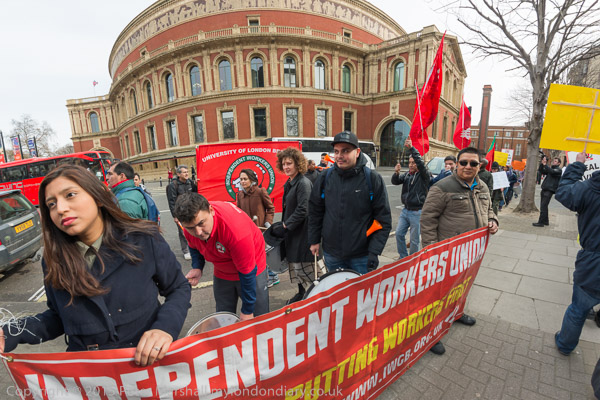
NIKON D800E: 16.0 mm f/2.8, 1/250s, f/8, ISO 200, -0.3Ev
When the protest moved around to the other end of the college, adjoining the Albert Hall I took some images using the 16mm fisheye to let me get close to the protesters and still show that building very recognisably in the background. Using the Fisheye-Hemi plugin does then eliminate some of the curvature and produce less distortion of people away from the centre – like the woman at the left edge. In the fisheye view she would be rather curved, and in a similar position on the 16mm rectilinear lens she would suffer a sideways stretch.
Tilting the fisheye when taking the picture has however resulted in verticals that diverge fairly dramatically towards the top of the picture. It perhaps helps in this composition. You can correct the divergence in Lightroom, but only at the expense of losing much of the image.
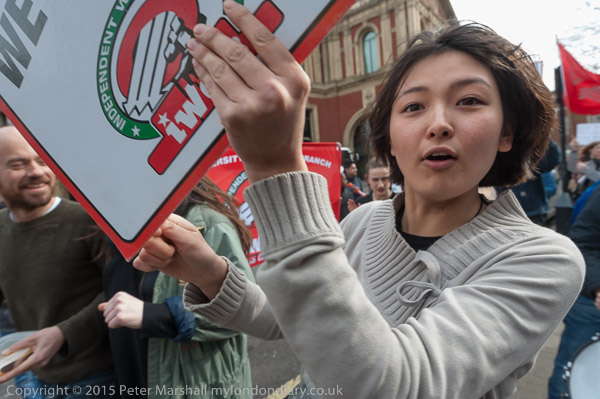
NIKON D700: 16.0-35.0 mm at 19mm, 1/200s, f/7.1, ISO 640, +0.7Ev
You can see some distortion in the face of the woman very close to the 16-35mm lens who was walking past me. Although often called ‘wide-angle distortion’ you can also get it from standard lenses when working very close to the subject. The relative distances from the centre and edges of the subject differ and thus so too does the magnification.
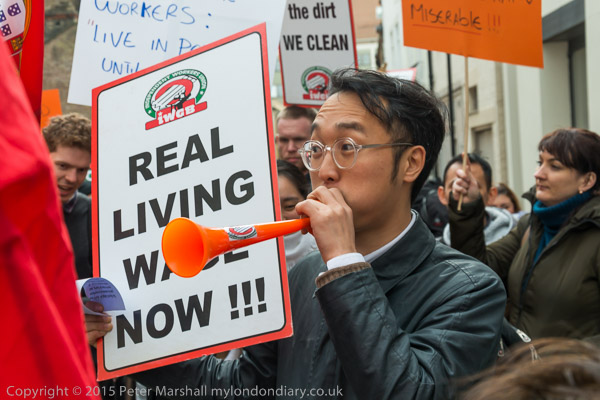
NIKON D800E: 18.0-105.0 mm at 45mm (68 equiv), 1/200s, f/7.1, ISO 200, -0.3Ev
Which is why a longer lens is more suitable when photographing fairly tight images of people, and a short telephoto – around 85mm on 35mm format – is often referred to as a ‘portrait lens‘. But you can of course take portraits with any lens. Hedgecoe’s best work was as a portrait photographer, particularly in black and white, and some of his best images were what is sometimes known as environmental portraiture, showing for example an artist in his studio, made with a wide angle to show the person in their surroundings. Others have made effective tightly cropped parts of faces with very long lenses.
______________________________________________________
My London Diary : Buildings of London : River Lea/Lee Valley : London’s Industrial Heritage
All photographs on this and my other sites, unless otherwise stated, are taken by and copyright of Peter Marshall, and are available for reproduction or can be bought as prints.
To order prints or reproduce images
________________________________________________________